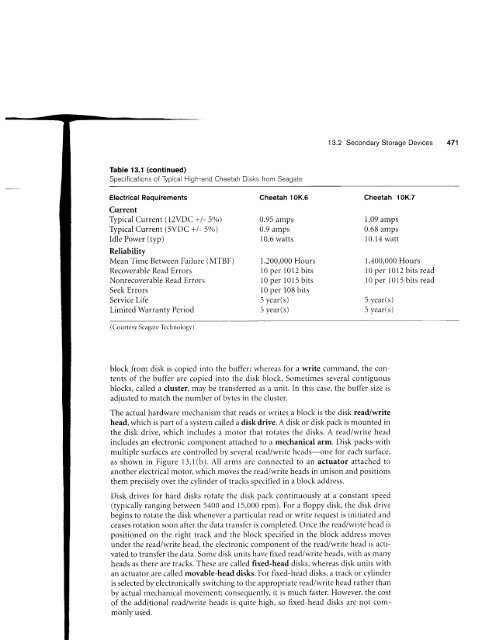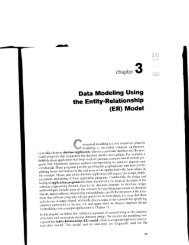13.1 through 13.5, 13.10 and 13.11
13.1 through 13.5, 13.10 and 13.11
13.1 through 13.5, 13.10 and 13.11
You also want an ePaper? Increase the reach of your titles
YUMPU automatically turns print PDFs into web optimized ePapers that Google loves.
13.2 Secondary Storage Devices 471Table <strong>13.1</strong> (continued)Specifications of Typical High-end Cheetah Disks from SeagateElectrical RequirementsCurrentTypical Current (12VDC +l- 5o/o)Typical Current (5VDC +l- 5o/o)Idle Power (typ)ReliabilityMean Time Between Failure (MTBF)Recoverable Read ErrorsNonrecoverable Read ErrorsSeek ErrorsService LifeLimited Warranty PeriodCheetah 'l 0K.60.95 amps0.9 amps10.6 watts1,200,000 Hours10 per 1012 bits10 per 1015 bitsl0 per 108 bits5 year(s)5 year(s)Cheetah 10K.71.09 amps0.68 amps10.14 watt1,400,000 Hoursl0 per l0l2 bits read10 per i015 bits read5 year(s)5 year(s)( Courtesy Seagate Tech nolog,v )block from disk is copied into the bufTer; whereas for a write comm<strong>and</strong>, the contentsof the buffer are copied into the disk block. Sometimes several contiguousblocks, called a cluster, may be transferred as a unit. In this case, the buffer size isadjusted to match the number of bytes in the cluster.The actual hardware mechanism that reads or writes a block is the disk read/writehead, which is part of a system called a disk drive. A disk or disk pack is mounted inthe disk drive, which includes .r motor that rotates the disks. A read/write headincludes an electronic component attached to a mechanical arm. Disk packs withmultiple surfaces are controlled by several read/write heads-one for each surface,as shown in Figure t3.l(b). All arms are connected to an actuator attached toanother electrical n-lotor, which moves the read/write heads in unison <strong>and</strong> positior-rsthem precisely over the cylinder of tracks specified in a block address.Disk drives for hard disks rotate the disk pack continuously at a constant speed(typically ranging between 5400 <strong>and</strong> 15,000 rpn-r). For a floppy disk, the disk drivebegins to rotate the disk whenever a particular read or rvrite request is initiated <strong>and</strong>ceases rotation soon after the data trar-rsfer is completed. Once the read/write head ispositioned on the right track <strong>and</strong> the block specified in the block address movesunder the read/write head, the electronic component of the read/write head is activatedto transfer the data. Son-re disk units have fixed read/write heads, with as manyheads as there are tracks. These are called fixed-head disks, whereas disk units withan actuator are called movable-head disks. For fixed-head disks, a track or cylinderis selected by electronically switching to the appropriate read/write head rather thanby actual mechanical movement; cor.rsequently, it is much fhster. However, the costof the additional read/write heads is quite high, so fixed-head disks are not commonlyused.














